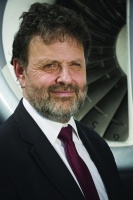Simon Howison, engineering director, BAE Systems Military Air Solutions
Air of Austerity: Despite the challenges facing the defence sector, BAE’s top military aerospace engineer is optimistic

The Farnborough Air Show – a week-long procession of multi-million-pound contracts, new technologies and corporate might – somehow doesn’t seem the right place to chat about austerity.
But, as the luxury jets thundered overhead, BAE’s engineering director for military aerospace, Simon Howison, was pretty clear on his sector’s number-one priority. ’The biggest driver,’ he said, ’is taking the cost out all the way through. How do you do the concept stuff better? How do you do the engineering better? How do you manufacture it better and how do you operate it at lower cost?’
I’m always an optimist who says out of change comes opportunity
As engineering leader and design-approval signatory for, among others, Eurofighter, Typhoon, Tornado and Nimrod, there’s a good argument for Howison being the most important figure in the UK’s military-aerospace sector. And, with the defence spending review looming large and speculation mounting that the MoD will have to make some tough decisions on its military-aircraft capability, he’s conscious that the way in which his group responds to the challenges ahead could have a profound impact on the UK’s future capabilities. ’It’s clear there’s a difficult environment and it’s going to have some impact in terms of what happens, and there will be some downsides,’ he said. ’But I also think there will be some upsides because there will be a clear focus as to what is important to the customer. It will change things, but I’m always an optimist who says out of change comes opportunity – and we may well find some opportunities out of all this.’
Register now to continue reading
Thanks for visiting The Engineer. You’ve now reached your monthly limit of premium content. Register for free to unlock unlimited access to all of our premium content, as well as the latest technology news, industry opinion and special reports.
Benefits of registering
-
In-depth insights and coverage of key emerging trends
-
Unrestricted access to special reports throughout the year
-
Daily technology news delivered straight to your inbox










Water Sector Talent Exodus Could Cripple The Sector
Maybe if things are essential for the running of a country and we want to pay a fair price we should be running these utilities on a not for profit...